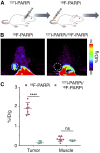PARP-1-Targeted Radiotherapy in Mouse Models of Glioblastoma
- PMID: 29572254
- PMCID: PMC6071508
- DOI: 10.2967/jnumed.117.205054
PARP-1-Targeted Radiotherapy in Mouse Models of Glioblastoma
Abstract
The DNA repair enzyme poly(ADP-ribose) polymerase 1 (PARP-1) is overexpressed in glioblastoma, with overall low expression in healthy brain tissue. Paired with the availability of specific small molecule inhibitors, PARP-1 is a near-ideal target to develop novel radiotherapeutics to induce DNA damage and apoptosis in cancer cells, while sparing healthy brain tissue. Methods: We synthesized an 131I-labeled PARP-1 therapeutic and investigated its pharmacology in vitro and in vivo. A subcutaneous tumor model was used to quantify retention times and therapeutic efficacy. A potential clinical scenario, intratumoral convection-enhanced delivery, was mimicked using an orthotopic glioblastoma model combined with an implanted osmotic pump system to study local administration of 131I-PARPi (PARPi is PARP inhibitor). Results:131I-PARPi is a 1(2H)-phthalazinone, similar in structure to the Food and Drug Administration-approved PARP inhibitor AZD-2281. In vitro studies have shown that 131I-PARPi and AZD-2281 share similar pharmacologic profiles. 131I-PARPi delivered 134.1 cGy/MBq intratumoral injected activity. Doses to nontarget tissues, including liver and kidney, were significantly lower. Radiation damage and cell death in treated tumors were shown by p53 activation in U87-MG cells transfected with a p53-bioluminescent reporter. Treated mice showed significantly longer survival than mice receiving vehicle (29 vs. 22 d, P < 0.005) in a subcutaneous model. Convection-enhanced delivery demonstrated efficient retention of 131I-PARPi in orthotopic brain tumors, while quickly clearing from healthy brain tissue. Conclusion: Our results demonstrate 131I-PARPi's high potential as a therapeutic and highlight PARP's relevance as a target for radionuclide therapy. Radiation plays an integral role in brain tumor therapy, and radiolabeled PARP therapeutics could ultimately lead to improvements in the standard of care.
Keywords: 131I; 131I-PARPi; PARP; convection enhanced delivery (CED); radiotherapeutic.
© 2018 by the Society of Nuclear Medicine and Molecular Imaging.
Figures





References
Publication types
MeSH terms
Substances
Grants and funding
LinkOut - more resources
Full Text Sources
Other Literature Sources
Research Materials
Miscellaneous
